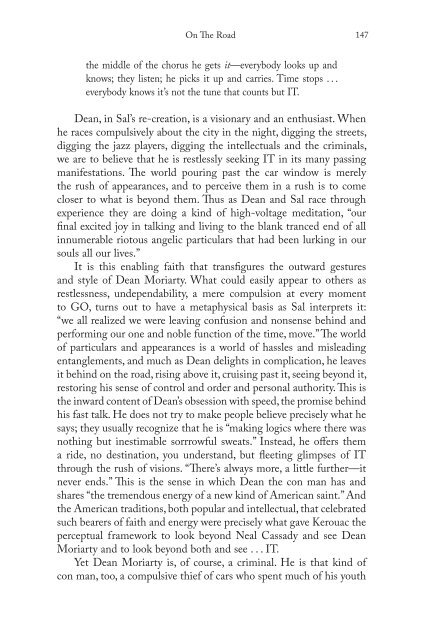Blooms Literary Themes - THE TRICKSTER.pdf - ymerleksi - home
Blooms Literary Themes - THE TRICKSTER.pdf - ymerleksi - home
Blooms Literary Themes - THE TRICKSTER.pdf - ymerleksi - home
You also want an ePaper? Increase the reach of your titles
YUMPU automatically turns print PDFs into web optimized ePapers that Google loves.
On Th e Road 147<br />
the middle of the chorus he gets it—everybody looks up and<br />
knows; they listen; he picks it up and carries. Time stops . . .<br />
everybody knows it’s not the tune that counts but IT.<br />
Dean, in Sal’s re-creation, is a visionary and an enthusiast. When<br />
he races compulsively about the city in the night, digging the streets,<br />
digging the jazz players, digging the intellectuals and the criminals,<br />
we are to believe that he is restlessly seeking IT in its many passing<br />
manifestations. Th e world pouring past the car window is merely<br />
the rush of appearances, and to perceive them in a rush is to come<br />
closer to what is beyond them. Th us as Dean and Sal race through<br />
experience they are doing a kind of high-voltage meditation, “our<br />
fi nal excited joy in talking and living to the blank tranced end of all<br />
innumerable riotous angelic particulars that had been lurking in our<br />
souls all our lives.”<br />
It is this enabling faith that transfi gures the outward gestures<br />
and style of Dean Moriarty. What could easily appear to others as<br />
restlessness, undependability, a mere compulsion at every moment<br />
to GO, turns out to have a metaphysical basis as Sal interprets it:<br />
“we all realized we were leaving confusion and nonsense behind and<br />
performing our one and noble function of the time, move.” Th e world<br />
of particulars and appearances is a world of hassles and misleading<br />
entanglements, and much as Dean delights in complication, he leaves<br />
it behind on the road, rising above it, cruising past it, seeing beyond it,<br />
restoring his sense of control and order and personal authority. Th is is<br />
the inward content of Dean’s obsession with speed, the promise behind<br />
his fast talk. He does not try to make people believe precisely what he<br />
says; they usually recognize that he is “making logics where there was<br />
nothing but inestimable sorrrowful sweats.” Instead, he off ers them<br />
a ride, no destination, you understand, but fl eeting glimpses of IT<br />
through the rush of visions. “Th ere’s always more, a little further—it<br />
never ends.” Th is is the sense in which Dean the con man has and<br />
shares “the tremendous energy of a new kind of American saint.” And<br />
the American traditions, both popular and intellectual, that celebrated<br />
such bearers of faith and energy were precisely what gave Kerouac the<br />
perceptual framework to look beyond Neal Cassady and see Dean<br />
Moriarty and to look beyond both and see . . . IT.<br />
Yet Dean Moriarty is, of course, a criminal. He is that kind of<br />
con man, too, a compulsive thief of cars who spent much of his youth

















